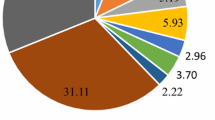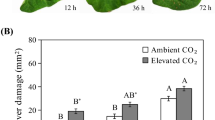Abstract
To better understand the effect of predicted elevated levels of carbon dioxide (CO2) on an invasive weed Mikania micrantha, we constructed a suppressive subtractive hybridization (SSH) library from the leaves of M. micrantha exposed to CO2 at 350 and 750 ppm for 6 d, and isolated a novel gene named β-caryophyllene synthase. β-Caryophyllene synthase catalyses the conversion of farnesyl diphosphate to β-caryophyllene, a volatile sesquiterpene with allelopathic potential. Real-time PCR analysis revealed that gene expression of β-caryophyllene synthase in M. micrantha leaves was strongly induced in response to elevated CO2. Gas chromatography-mass spectrometry (GC-MS) and gas chromatography (GC) analyses showed that emission levels of β-caryophyllene from leaves of M. micrantha increased when exposed to 750 ppm CO2. Bioassays showed that phytotoxicity of β-caryophyllene against Raphanus sativus, Brassica campestris, Lactuca sativa, and M. micrantha was dose-dependent and varied with the receptor plants and concentrations of CO2. β-Caryophyllene displayed higher phytotoxic effects at 750 ppm than those at 350 ppm CO2, especially on R. sativus. These results suggest that elevated atmospheric CO2 levels may enhance biosynthesis and phytotoxicity of allelochemicals in M. micrantha, one of the worst invasive weeds in the world, which in turn might enhance its potential allelopathic effect on neighboring native plants if released in bioactive concentrations. Further investigations are required to determine the adaptive responses of both invasive and native plants to a gradual increase of atmospheric CO2 to 750 ppm predicted over a 100 year period.


Similar content being viewed by others
References
Abdelgaleil, S. A. M., and Hashinaga, F. 2007. Allelopathic potential of two sesquiterpene lactones from Magnolia grandiflora L. Biochem. Syst. Ecol. 35:737–742.
Abdelgaleil, S. A. M., Abdel-Razeek, N., and Soliman, S. A. 2009. Herbicidal activity of three sesquiterpene lactones on wild oat (Avena fatua) and their possible mode of action. Weed Sci. 57:6–9.
Altschul, S. F., Madden, T. L., Schaffer, A. A., Zhang, J., Zhang, Z., Miller, W., and Lipman, D. J. 1997. Gapped BLAST and PSI-BLAST: a new generation of protein database search programs. Nuc. Acids Res. 25:3389–3402.
Anaya, A. L. 1999. Allelopathy as a tool in the management of biotic resources in agroecosystems. Crit. Rev. Plant Sci. 18:697–739.
Bagchi, G. D., Haider, F., Dwivedi, P. D., Singh, A., and Naqvi, A. A. 2003. Essential oil constituents of Artemisia annua during different growth periods at monsoon conditions of Subtropical North Indian plains. J. Essent. Oil Res. 15:248–250.
Beuf, L., Kurano, N., and Miyachi, S. 1999. Rubisco activase transcript (rca) abundance increases when the marine unicellular green alga Chlorococcum littorale is grown under high-CO2 stress. Plant Mol. Biol. 41:627–635.
Cai, Y., Jia, J. W., Crock, J., Lin, Z. X., Chen, X. Y., and Croteau, R. 2002. A cDNA clone for β-caryophyllene synthase from Artemisia annua. Phytochemistry. 61:523–529.
Callaway, R. M., and Aschehoug, E. T. 2000. Invasive plants versus their new and old neighbors: a mechanism for exotic invasion. Science. 290:521–523.
Cheng, A. X., Xiang, C. Y., Li, J. X., Yang, C. Q., Hu, W. L., Wang, L. J., Lou, Y. G., and Chen, X. Y. 2007. The rice (E)-β-caryophyllene synthase (OsTPS3) accounts for the major inducible volatile sesquiterpenes. Phytochemistry. 68:1632–1641.
Chomczynski, P., and Sacchi, N. 2006. The single-step method of RNA isolation by acid guanidinium thiocyanate-phenol-chloroform extraction: twenty-something years on. Nat. Protoc. 1:581–585.
Cock, M. J. W., Ellison, C. A., Evans, H. C., and Ooi, P. A. C. 2000. Can failure be turned into success for biological control of mile-a-minute weed (Mikania micrantha)? pp. 155–167, in N. R. Spencer (ed.). Proceedings of the X International Symposium on Biological Control of Weeds. Bozeman, Montana.
Collins, S., and Bell, G.. 2004. Phenotypic consequences of 1,000 generations of selection at elevated CO2 in a green alga. Nature. 431:566–569.
Constable, J. V. H., Guenther, A. B., Schimel, D. S., and Monson, R. K. 1999. Modelling changes in VOC emission in response to climate change in the continental United States. Global Change Biol. 5:791–806.
Diatchenko, L., Lau, Y. F., Campbell, A. P., Chenchik, A., Moqadam, F., Huang, B., Lukyanov, S., Lukyanov, K., Gurskaya, N., and Sverdlov, E. D. 1996. Suppression subtractive hybridization: a method for generating differentially regulated or tissue-specific cDNA probes and libraries. Proc. Natl. Acad. Sci. USA. 93:6025–6030.
Dicke, M., Sabelis, M. W., Takabayashi, J., Bruin, J., and Posthumus, M. A. 1990. Plant strategies of manipulating predatorprey interactions through allelochemicals: Prospects for application in pest control. J. Chem. Ecol. 16:3091–3118.
Duke, S. O. 2007. Weeding with allelochemicals and allelopathya commentary. Pest Manag. Sci. 63:307–307.
Falkowski, P., Scholes, R. J., Boyle, E., Canadell, J., Canfield, D., Elser, J., Gruber, N., Hibbard, K., Högberg, P., Linder, S., Mackenzie, F. T., Moore, III. B., Pedersen, T., Rosenthal, Y., Seitzinger, S., Smetacek, V., and Steffen, W. 2000. The global carbon cycle: a test of our knowledge of earth as a system. Science. 290:291–296.
Fischer, N. H., Weidenhamer, J. D., and Bradow, J. M. 1989. Inhibition and promotion of germination by several sesquiterpenes. J. Chem. Ecol. 15:1785–1793.
Gershenzon, J., and Croteau, R. 1993. Terpenoid biosynthesis: the basic pathway and formation of monoterpenes, sesquiterpenes and diterpenes. Lipid Metabolism in Plants, pp. 339–388. CRC, Boca Raton.
Gómez-Aparicio, L., and Canham, C. D. 2008. Neighbourhood analyses of the allelopathic effects of the invasive tree Ailanthus altissima in temperate forests. J. Ecol. 96:447–458.
Granados, J., and Körner, C. 2002. In deep shade, elevated CO2 increases the vigor of tropical climbing plants. Global Change Biol. 8:1109–1117.
Hansen, U., and Seufert, G. 2003. Temperature and light dependence of β-caryophyllene emission rates. J. Geophys. Res. 108:4801.
Himanen, S. J., Nerg, A. M., Nissinen, A., Pinto, D. M., Stewart, C. N., Poppy, G. M., and Holopainen, J. K. 2009. Effects of elevated carbon dioxide and ozone on volatile terpenoid emissions and multitrophic communication of transgenic insecticidal oilseed rape (Brassica napus). New Phytol. 181:174–186.
Inderjit., and Duke, S. O. 2003. Ecophysiological aspects of allelopathy. Planta. 217:529–539.
Ismail, B. S., and Chong, T. V. 2002. Effects of aqueous extracts and decomposition of Mikania micrantha H. B. K. debris on selected agronomic crops. Weed Biol. Manag. 2:31–38.
Iwasaki, I., Hu, Q., Kurano, N., and Miyachi, S. 1998. Effect of extremely high-CO2 stress on energy distribution between photosystem I and photosystem II in a ‘high-CO2’ tolerant green alga, Chlorococcum littorale and the intolerant green alga Stichococcus bacillaris. J. Photochem. Photobiol. 44:184–190.
Jump, A. S., and Penuelas, J. 2005. Running to stand still: adaptation and the response of plants to rapid climate change. Ecol. Lett. 8: 1010–1020.
Kegge, W., and Pierik, R. 2010. Biogenic volatile organic compounds and plant competition. Trends Plant Sci. 15: 126–132.
Kil, B. S., Han, D. M., Lee, C. H., Kim, Y. S., Yun, K. Y., and Yoo, H. G. 2000. Allelopathic effects of Artemisia lavandulaefolia. Korean J. Ecol. 23:149–155.
Klironomos, J. N., Allen, M. F., Rillig, M. C., Piotrowski, J., Makvandi-Nejad, S., Wolfe, B. E., and Powell, J. R. 2005. Abrupt rise in atmospheric CO2 overestimates community response in a model plant-soil system. Nature. 433:621–624.
Lee, K. A., and Klasing, K. C. 2004. A role for immunology in invasion biology. Trends Ecol. Evol. 19:523–529.
Legrand, C., Rengefors, K., Fistarol, G.. O., and Graneli, E. 2003. Allelopathy in phytoplankton: biochemical, ecological and evolutionary aspects. Phycologia. 42:406–419.
Livak, K. J., and Schmittgen, T. D. 2001. Analysis of relative gene expression data using real-time quantitative PCR and the 2-ΔΔCT method. Methods. 25:402–408.
Macías, F. A., Torres, A., Molinllo, J. M. G., Varela, R. M., Castellano, D. 1996. Potential allelopathic sesquiterpene lactones from sunflower leaves. Phytochemistry. 43:1205–1215.
Maffei, E. M. D., Marin-Morales, M. A., Ruas, P. M., Ruas, C. F., and Matzenbacher, N. I. 1999. Chromosomal polymorphism in 12 populations of Mikania micrantha (Compositae). Genet. Mol. Biol. 22:433–444.
Ni, G. Y., Song, L. Y., Zhang, J. L., and Peng, S. L. 2006. Effects of root extracts of Mikania micrantha H. B. K. on soil microbial community. Allelopathy J. 17:247–254.
Niinemets, Ü., Loreto, F., and Reichstein, M. 2004. Physiological and physicochemical controls on foliar volatile organic compound emissions. Trends Plant Sci. 9:180–186.
Polle, A., Eiblmeier, M., Sheppard, L., and Murray, M. 2008. Responses of antioxidative enzymes to elevated CO2 in leaves of beech (Fagus sylvatica L.) seedlings grown under a range of nutrient regimes. Plant Cell Environ. 20:1317–1321.
Possell, M., Hewitt, N. C., and Beerling, D. J. 2005. The effects of glacial atmospheric CO2 concentrations and climate on isoprene emissions by vascular plants. Global Change Biol. 11:60–69.
Rapparini, F., Baraldi, R., Miglietta, F., and Loreto, F. 2004. Isoprenoid emission in trees of Quercus pubescens and Quercus ilex with lifetime exposure to naturally high CO2 environment. Plant Cell Environ. 27:381–391.
Rosenstiel, T. N., Potosnak, M. J., Griffin, K. L., Fall, R., and Monson, R. K. 2003. Increased CO2 uncouples growth from isoprene emission in an agriforest ecosystem. Nature. 421:256–259.
Sasek, T. W., and Strain, B. R. 1991. Effects of CO2 enrichment on the growth and morphology of a native and an introduced honeysuckle vine. Am. J. Bot. 78:69–75.
Shao, H., Peng, S. L., Wei, X. Y., Zhang, D. Q., and Zhang, C. 2005. Potential allelochemicals from an invasive weed Mikania micrantha H.B.K. J. Chem. Ecol. 31:1657–1668.
Sharkey, T. D., and Singsaas, E. L. 1995. Why plants emit isoprene. Nature. 374:769–769.
Singh, H. P., Batish, D.R., and Kohli, R. K. 2003. Allelopathic interactions and allelochemicals: new possibilities for sustainable weed management. Crit. Rev. Plant Sci. 22:239–311.
Song, L. Y., Wu, J. R., Li, C. H., Li, F. R., Peng, S. L., and Chen, B. M. 2009. Different responses of invasive and native species to elevated CO2 concentration. Atca Oecol. 35:128–135.
Staudt, M., Joffre, R., Rambal, S., and Kesselmeier, J. 2001. Effect of elevated CO2 on monoterpene emission of young Quercus ilex trees and its relation to structural and ecophysiological parameters. Tree Physiol. 21:437–445.
Tiiva, P., Faubert, P., Michelsen, A., Holopainen, T., Holopainen, J. K., and Rinnan, R. 2008. Climatic warming increases isoprene emission from a subarctic heath. New Phytol. 180:853–863.
Valladares, F., Gianoli, E., and Gómez, J. M. 2007. Ecological limits to plant phenotypic plasticity. New Phytol. 176:749–763.
Walther, G. R. 2003. Plants in a warmer world. Perspect. Plant Ecol.6:169–185.
Wang, R. L., Peng, S. L., Zeng, R. S., Ding, L. W., and Xu, Z. F. 2009. Cloning, expression and wounding induction of β-caryophyllene synthase gene from Mikania micrantha H. B. K. and allelopathic potential of β-caryophyllene. Allelopathy J. 24:35–44.
Ward, J. K., and Kelly, J. K. 2004. Scaling up evolutionary responses to elevated CO2: lessons from Arabidopsis. Ecol. Lett. 7:427–440.
Williamson, G. B., and Richardson, D. 1988. Bioassays for allelopathy: Measuring treatment responses with independent controls. J. Chem. Ecol. 14:181–187.
Zhang, L. Y., Ye, W. H., Cao, H. L., and Feng, H. L. 2004. Mikania micrantha H. B. K. in China—an overview. Weed Res. 44:42–49.
Zotz, G., Cueni, N., and Körner, C. 2006. In situ growth stimulation of a temperate zone liana (Hedera helix) in elevated CO2. Funct. Ecol. 20:763–769.
Acknowledgements
We thank Prof. Azim Mallik for linguistic corrections and help with the introduction and discussion of the paper. Three anonymous reviewers provided valuable suggestions to improve the manuscript. This research was financially supported by the Key Program of Ministry of Education of China (No.704037), the Natural Science Fund of Guangdong (9251027501000006) and the National Natural Science Foundation of China (No.30670385).
Author information
Authors and Affiliations
Corresponding author
Rights and permissions
About this article
Cite this article
Wang, RL., Staehelin, C., Peng, SL. et al. Responses of Mikania micrantha, an Invasive Weed to Elevated CO2: Induction of β-Caryophyllene Synthase, Changes in Emission Capability and Allelopathic Potential of β-Caryophyllene. J Chem Ecol 36, 1076–1082 (2010). https://doi.org/10.1007/s10886-010-9843-x
Received:
Revised:
Accepted:
Published:
Issue Date:
DOI: https://doi.org/10.1007/s10886-010-9843-x




